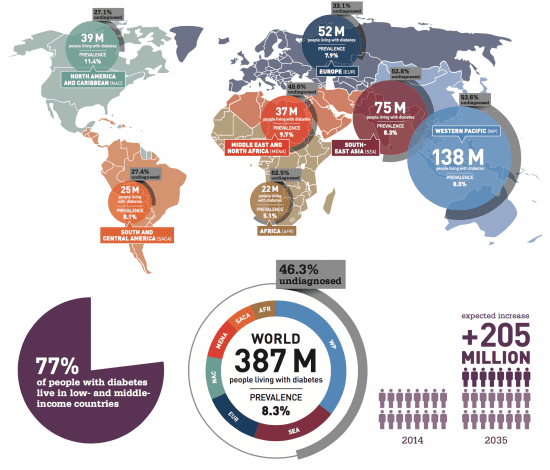Today is World Diabetes Day. This day is personal for me. In fact, it’s personal for many.
Diabetes affects 387 million people around the world and results in up to 5 million deaths every year. The International Diabetes Federation has put together the “Diabetes Atlas” to illustrate the global problem, all the challenges and the big threat that diabetes poses to human development.
Those are the numbers. They are staggering.
And then there are the human stories. Behind every single one of those figures are stories that need to be told and that need to lie at the heart of our global response to diabetes.
This is personal to me. Less than a year ago, I lost my beloved aunt to diabetes. It still seems like yesterday that my mom had to tell me of the passing away of my aunty. It still feels like yesterday that I accompanied her together with my dad to the treatment facility for dialysis – three times per week. I did that whenever I visited back home. And it still feels like yesterday when I would sit with her, discussing books and my favorit singers…
Me and my family, we had to experience how crucial, in fact life-saving or life-destroying, a functioning and well-constructed healthcare system is. Where I live today, people benefit from a well-financed healthcare system. Where I come from and where my aunty was living, the healthcare system was rationalised away and dismantled. Spending cuts. My aunt used to live healthy in many ways. She lived free from alcohol and tobacco. And she ate locally produced foods. But as the hospitals and doctors disappeared from her city, so did society’s ability to care for those who become ill, like her, and support them in living a decent, dignified life.
In just a few sentences this is the story of my family, deeply and sadly affected by diabetes and by political decisions that undermined society’s ability to care for and take care of people affected by the disease. As the graphic above shows, 77% of the 387 Million people living with diabetes are from low- and middle-income countries. Millions of people are right now left to largely fend for themselves, to deal with diabetes on their own, must rely on the support of their families and the community around them.
We can change that. We must change that. It’s personal. It’s global.
I believe that change is a matter of political will and political decisions to change the trend: projections of the current developments indicate that by 2035 – in 21 years – there will be 205 million additional people suffering from diabetes. This can largely be prevented and we do already have the tools. Let me give you a number of key words:
Create and promote environments that enable healthy lifestyle choices
Healthy eating options must be available and affordable and should become the natural choice for people, especially children and adolescents, around the world.
The use of alcohol should be addressed as the risk factor for diabetes, that it is – and more alcohol free environments should be available.
Places where people live, especially cities, should offer public spaces that encourage physical activity.
Modify the risk factors for Non-communicable diseases and reduce their health burden
An integrated approach of three best buys measures to control and prevent NCDs should be employed. Concretely it means that 1) bans of advertising and sponsorship of companies that manufacture products that cause and are risk factors for NCDs – Big Alcohol, Big Soda, Big Food are companies that literally manufacture disease by aggressively targeting their marketing messages to vulnerable groups, such as children and youth. It further means that 2) policy measures decreasing the affordability of products that are associated with NCDs, such as diabetes, need to be employed. Taxation is proven to be cost-effective and high-impact, for example when it comes to higher taxes on sugary drinks, alcohol and fast food. And last but not least it means that 3) policy measures decreasing the availability of harmful products should be put in place. The regulation of outlet density, age limits and the investment in environments that offer and support healthy lifestyle choices are high-impact and cost-effective measures.
And yes, in order to sustainably reduce and prevent diabetes, alcohol needs to be addressed. Alcohol does not only cause cancer and heart disease. Evidence shows that alcohol use is related to diabetes – in several different ways:
- Alcohol contains high amounts of calories, carbohydrates and very often large amounts of sugar, which makes alcohol products an often forgotten contributing factor to obesity. Overweight greatly increases the risk for type 2 diabetes.
- Alcohol can cause chronic inflammation of the pancreas (pancreatitis), which can impair its ability to secrete insulin and ultimately lead to diabetes. The more a person uses alcohol, the greater the risk for diabetes.
- Alcohol interacts with diabetes medications. Alcohol can cause blood glucose levels to rise or fall, depending on how much you consume. Some diabetes pills also lower blood glucose levels by stimulating the pancreas to make more insulin. Combining the blood-sugar-lowering effects of the medication with alcohol can lead to hypoglycaemia or “insulin shock,” which is a medical emergency.
- Alcohol hinders the liver from doing its job. When alcohol is consumed, the liver has to work hard to remove alcohol – a toxic substance to the body – from the blood instead of working to regulate blood sugar.
- Alcohol can cause hypoglycaemia. Within a few minutes of alcohol intake, alcohol can cause the blood glucose level to drop.
- Alcoholic Ketoacidosis. Cells need glucose and insulin to function properly. When alcohol is consumed, the pancreas may stop producing insulin for a short time. Without insulin, cells are not able to use the glucose that is consumed for energy. To get the energy needed, the human body does start to burn fat. When the body burns fat for energy, by-products known as ketones bodies are produced. If the body is not producing insulin, ketone bodies will begin to build up in the bloodstream. This buildup of ketone can produce a life-threatening condition known as ketoacidosis. Ketoacidosis caused by the consumption of alcohol is known as alcoholic ketoacidosis. Ketoacidosis can also develop in patients who have diabetes.
- Binge alcohol use directly causes insulin resistance, which in turn leads to type 2 diabetes. Alcohol appears to disrupt insulin-receptor signalling by causing inflammation in the hypothalamus, an area of the brain that among other things, is important for metabolic processes.
- Alcohol consumption can worsen diabetes-related medical complications, such as disturbances in fat metabolism, nerve damage, and eye disease.
You can read these as eight bullet points that don’t really affect you, that don’t really matter.
But you also have a different choice. I started this blog by writing that this issue is personal. Almost anyone knows someone close that suffers from diabetes. Do they know these facts? My experience tells me that diabetes patients hardly know anything about alcohol use and diabetes. They should because it can save their lives.
People at risk of diabetes don’t know much about these eight bullet points either. This fact becomes scary if you revisit the graphic above:
- 46,3% of people with diabetes don’t even know they suffer from this disease.
And that means that they put themselves into risk when using alcohol – without even being aware of it.
And thirdly we can see that alcohol should be addressed in our global response to the diabetes epidemic. Alcohol policy measures can help to sustainably reduce diabetes and to prevent many cases of diabetes. For millions of people around the world this is personal. For me this is personal. Let’s make it personal for the global diabetes community, the NCDs community and for the decision-makers in our communities and countries.


Hi Kristina,
First off, I came across your site and wanted to say thanks for providing a great diabetes resource to the community.
This hilarious list, 29 Things Only a Person with Diabetes Would Understand, has really resonated with our followers because it provides emotional support and understanding in a comical way, and I thought you might enjoy it as well: http://www.healthline.com/health/diabetes/would-understand
Naturally, I’d be delighted if you share this list on http://movendi.ngo/blog/2014/11/14/a-personal-story-on-diabetes/ , and/or on social , especially because they could really relate. Either way, keep up the great work Kristina!
All the best,
Nicole Lascurain [ Assistant Marketing Manager ]
t: 415-281-3100 f: 415-281-3199
Healthline Media, Inc.
660 Third Street, San Francisco, CA 94107
http://www.healthline.com – @healthline – @HealthlineAdLab
About Us: http://www.healthline.com/health/about-us